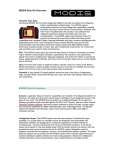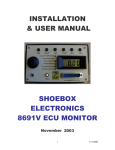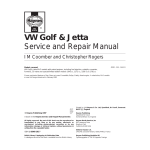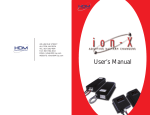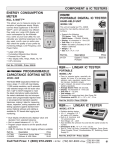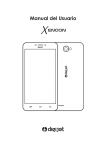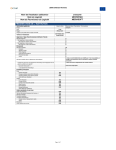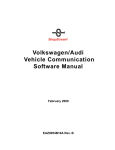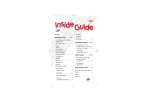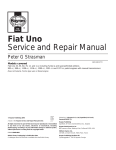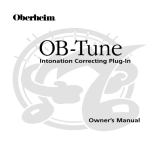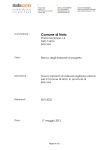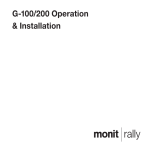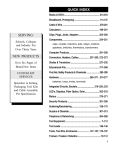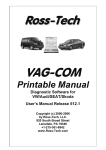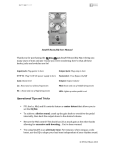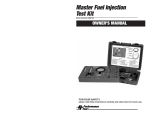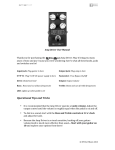Download SHOEBOX ELECTRONIX 8385V ECU MONITOR USER MANUAL
Transcript
SHOEBOX ELECTRONIX 8385V ECU MONITOR USER MANUAL & TROUBLESHOOTING GUIDE Sept 28, 2008 10/5/2008 1 Table of Contents Your Vanagon & it’s ECU................................................................................................. 3 Vanagon ECU & System Components.............................................................................. 4 ECU Input Signals ............................................................................................................. 5 ECU Output Signals .......................................................................................................... 5 Observing Signals on the ECU Monitor ........................................................................... 6 Digital Panel Meter............................................................................................................ 8 Monitor Status Indicators.................................................................................................. 9 Digijet System Components ............................................................................................. 10 Electronic Control Unit (or ECU) ............................................................................. 10 Coolant Temperature Sensor..................................................................................... 10 Air Flow Sensor........................................................................................................... 11 Intake Air Temperature Sensor ................................................................................ 11 Fuel Pressure Regulator ............................................................................................. 12 Fuel Injectors............................................................................................................... 12 Throttle Switches ........................................................................................................ 13 Oxygen Sensor............................................................................................................. 14 Ignition System / Idle Stabilization ........................................................................... 15 Idle Speed Boost Valves.............................................................................................. 16 Auxiliary Air Regulator ............................................................................................. 16 Starting Enrichment Time ......................................................................................... 17 Warm-Up Enrichment................................................................................................ 17 Crankcase Emission Control ..................................................................................... 17 Vent Line Heating Element (Canadian vehicles only)............................................. 17 Evaporative Emission System.................................................................................... 18 Troubleshooting ............................................................................................................... 19 Basics............................................................................................................................ 19 Troubleshooting Guidelines ....................................................................................... 19 Symptom Troubleshooting Guide ............................................................................. 20 Addendum......................................................................................................................... 22 Wiring Diagrams / Reference .................................................................................... 22 Shoebox Electronix Website....................................................................................... 22 10/5/2008 2 Your Vanagon & it’s ECU It is important for the ECU Monitor System to work for you effectively, that your engine be tuned to its best possible running condition. Spark plugs, spark plug wires, rotor cap, and distributor rotor should first be replaced. and all basic engine adjustments (timing, etc) verified. We are assuming that your problem is intermittent, or at temperature, and that your engine is able to be tuned and will run. If your problem is an inability to start the engine cold, then proceed to the System Troubleshooting Guide on page 18. Most 1983 ½ through 1986 Vanagons utilize the Bosch (or Bosch equivalent) Electronic Control Unit, or ECU, to electrically enable the fuel pump, and control the fuel injection pulse duration. This duration is based on inputs to the ECU, specifically: • • • • • • • • Engine speed Intake air temperature Intake air volume Coolant temperature Throttle position Oxygen content in the exhaust gas Battery Voltage Throttle valve position An emergency operation function is incorporated into the ECU circuit in the event of a faulty air intake or coolant temperature sensor. 10/5/2008 3 Vanagon ECU & System Components The ECU is but one component, albeit an important one, in the Vanagon engine. While the ECU is like the quarterback, all the players must contribute efficiently to make the team run smoothly. The basic requirements for an internal combustion engine to operate are fuel, spark, and air. The modern engine utilizes electronic technology to constantly monitor sensor inputs and control the fuel pump and fuel injection pulse duration. This drawing shows the relationship of the ECU to the other components of your engine that connect to it: So, as you can see, the Bosch ECU does a lot of work, but it is not rocket science by any means. The Bosch ECU is a relatively simple signal converter and interface, which does the work of previously separate external sub-systems (e.g. the old mechanical choke has been replaced by the fuel injector pulse width (wider pulse = more gas). Once you understand what it does, it is easier to understand problems associated with it. 10/5/2008 4 ECU Input Signals The ECU relies upon input signals to allow it to decide what to tell your engine. As your engine temperature increases as it warms up, the ECU will continuously adjust and injector pulses accordingly. As you drive, the ECU senses changes from the air flow meter, oxygen sensor, air temperature, and Hall sensor. The old computer rule, “GIGO” (garbage in, garbage out) applies here. If any of the input signals is incorrect or intermittent, the ECU output signals will also be incorrect or intermittent. Normally, bad sensors cause bad inputs. It is possible that your ECU is at fault, but more common that a bad sensor input is causing your grief. ECU INPUT SIGNAL Coolant Temperature Air Temperature Battery Voltage Engine RPM Oxygen Sensor Voltage Air Flow Meter Volume Throttle Position SOURCE Coolant Temperature Sensor Air Temperature Sensor 12V B+ engine wiring harness Ignition Control Unit O2 sensor on catalytic converter Air flow meter potentiometer Throttle position switch ECU Output Signals Based upon the signals supplied to the ECU, the ECU in turn provides output signals to allow proper engine operation: ECU OUTPUT SIGNAL Fuel Injector Pulses Fuel Pump Enable DESTINATION Fuel Injector Solenoids Fuel Pump (Relay) 10/5/2008 5 Observing Signals on the ECU Monitor Place the Monitor in a convenient viewing location (we like the passenger seat, but if you are carrying a passenger who refuses to ride in the back seat, you can place it on the floor between the front seats (best for viewing in bright sunlight). Turn your ignition switch to the ACC position. Rotate the selector switch knob on the ECU Monitor CW with the line on the knob at 6 o’clock. Turn your ignition switch to the ACC position. Turn the ECU Monitor power switch ON. The green THROTTLE POSITION SWITCH, FUEL PUMP, FUEL INJ, & COIL PULSE LEDs should be illuminated, and the START/RUN & HALL PULSE LEDs should be extinguished. The digital display should display your Vanagon battery voltage. 10/5/2008 6 Start your engine. While your starter is engaged, the green START RUN LED will illuminate. After your engine is running, the START RUN LED will extinguish. The battery voltage indicated should be greater than the reading with your ignition key in the ACC position. The remaining green LEDs should illuminate: Rotate the selector switch to the full CCW position, COOLANT TEMPERATURE. This should illuminate the red coolant temperature indicator, and the digital display should indicate approximately 0.16V. This value will depend on the outside and engine temperature at the time… 10/5/2008 7 Digital Panel Meter You can display different sensor voltages by rotating the selector switch to the desired position. The approximate values are as follows: SENSOR COOLANT TEMPERATURE AIR TEMPERATURE AIR FLOW METER O2 SENSOR O2 SENSOR GROUND BATTERY VOLTAGE COLD (key on) 1.03V IDLE 0.18V 1.17V 0V (APPROX) 0.65V 0 V (APPROX) 12.0V 1.19V 1.10V 0.2 to 0.9V * 0V 13.50V 30 MPH 0.10V 1.16V 1.54V 0.2-0.9V 0V 13.50V 60MPH 0.10V 1.21V 2.93V 0.2-0.9V 0V 13.50V Keep in mind as you use this system, that exact sensor voltage values are normally not as important as the linearity and presence of the signal. As an example, your coolant temperature might indicate .12V at temperature, but appears linear between cold and hot, and the display is steady. A bad temperature sensor will normally be either very far from a normal value, but also and more importantly, display an erratic value either all the time or intermittently. This might be a display varying between .3 and 2.5V with or without an accompanying engine miss. Take your Vanagon out for a drive, observing (SAFELY) the sensor voltages displayed on the digital meter. You will quickly see the sensor values change as engine temperature, RPM, and outside air temperatures change. * The oxygen sensor reading will display relatively steady at first (approx .6V) but after warm up, with your engine at temperature, it will be constantly correcting the feedback signal to the ECU to stay in synch with the amount of fuel in your catalytic converter. The normal search range is approximately 0.2 - 0.9V. 10/5/2008 8 Monitor Status Indicators The Monitor Status Indicators are located above the digital meter. START/RUN The START/RUN indicator should be ON when you first turn your key to the START position of the ignition switch, and remain OFF during normal engine operation. It represents the starter being energized. If you do not see this indicator illuminated when you start your engine, chances are your engine will not start. THROTTLE POSITION SWITCH This indicator provides an indication of the position of the throttle – either fully closed, indicator ON, normal running OFF or fully open, indicator ON. If you see this indicator do anything else, like going into the ON state while you are at anything but idle or full throttle, there is a problem with your throttle position switch. FUEL PUMP This LED indicates a ground being provided to energize the fuel pump relay. Once again, this is necessary for your fuel pump to provide fuel to your engine. Any variation, and your engine will either not run, or will run intermittently. The fuel pump relay is a good place to start troubleshooting this type of problem. FUEL INJECTOR PULSE The fuel injector pulse indicator represents the pulses sent to the fuel injector solenoids. This pulse signal should be present whenever the engine is running. The indicator brightness will vary with the engine RPM – lower RPM, more apparent blinking, Higher RPM, appears almost steady brightness. HALL PULSE Since the ignition Control Unit generates a Hall pulse, this indicator reflects the ICU engine RPM signal output to the ECU, indicating normal Ignition System operation. COIL PULSE Rather than a true pulse, this LED indicates +12V supplied to the ignition coil primary & the fuel pump relay coil. This signal is necessary for your engine to start & run. 10/5/2008 9 Digijet System Components Electronic Control Unit (or ECU) The Digijet electronic control unit incorporates all the functions of the fuel system and ignition system and provides both the actuation signal for the fuel injectors and optimum ignition timing point for all engine operating conditions. Injection duration opening signals are provided based on the following inputs: • • • • • • Engine speed Intake air volume Coolant temperature Oxygen content in the exhaust gas Battery voltage Intake air temperature The injector opening time is taken from a program in the control unit at 16 points for RPM, and 16 points for load, for a total of 256 operational points. Injection times can be determined between these fixed points for a total of 65,000 theoretical different opening points. Coolant Temperature Sensor The coolant temperature sensor is a negative temperature coefficient resistor (NTC). The voltage signal it produces is used by the control unit to: • Determine cold-start and warm-up enrichment • Provide a signal to continue to enrich the mixture during engine warm up. 10/5/2008 10 Air Flow Sensor The airflow sensor measures the amount of air entering the intake manifold and sends a voltage signal representing this amount to the control unit. . Intake air opens the airflow sensor flap, which actuates the potentiometer to determine the voltage signal. This signal and the engine speed information provided by the Hall sender are used as the principal inputs for the determination of fuel injection opening duration. A compensation flap moves in a damping chamber to dampen sudden movements of the air sensor flap due to oscillations of the intake air. Intake Air Temperature Sensor An intake air temperature sensor is mounted in the airflow sensor housing. It is a negative temperature coefficient (NTC) resistor, which means its resistance value drops as the temperature increases. The signal it supplies to the ECU is used to modify fuel injection rate depending on intake air temperature. 10/5/2008 11 Fuel Pressure Regulator The system pressure regulator maintains a constant fuel pressure to all injectors by regulating the quantity of fuel returned to the fuel tank. The regulator is connected to the intake manifold. It responds to intake manifold vacuum fluctuations, thereby compensating for changes in engine load. When the engine is shut off, the regulator closes and seals to maintain fuel pressure in the injector lines for improved hot start capability. Fuel Injectors Digijet fuel injectors are electronically controlled on/off valves. A solenoid actuates a needle valve allowing fuel to be forced through the injector nozzle at system pressure. All four injectors open simultaneously and inject fuel directly into the intake manifold near each intake valve. Injector opening time is regulated by the ECU based on inputs from the various engine sensors. The ECU controls opening time by regulating the injector grounds. Power is supplied constantly to the injectors while the ignition is on. Note: Digijet injectors (yellow body) are NOT interchangeable with AFC (blue body) injectors. 10/5/2008 12 Throttle Switches Two micro switches are mounted on the throttle housing. The idle switch is adjusted to close 0 deg, 30 deg before the throttle closes. This sends a ground signal to the control unit in order to control fuel shut-off during deceleration. The second switch closes at full throttle. The control unit will then enrich the fuel mixture until the throttle is released. Note: As of engine # DH033353 (approximately mid produnction for the 1985 model year, the two switches were combined into a single switch which mounts on the underside of the throttle body. 10/5/2008 13 Oxygen Sensor The oxygen sensor is connected directly to the ECU. The ECU processes the voltage signal from the oxygen sensor and adjusts the opening duration of the fuel injectors. The oxygen sensor system is deactivated during engine warm-up, full throttle enrichment, and fuel cut-off during deceleration. 10/5/2008 14 The oxygen sensor is made of a ceramic material called Zirconium Dioxide. The inner and outer surfaces of the ceramic material are coated with platinum. The outer platinum surface is exposed to the exhaust gas, while the inner surface is exposed to the outside air. The difference in the amount of oxygen contacting the inner and outer surfaces creates a pressure differential, which results in a small voltage signal in the range of 175 – 1,100 millivolts (0.175 – 1.10 volts) supplied to the ECU. The fuel mixture determines the amount of voltage produced. A higher voltage indicates a rich mixture, and a lower voltage indicates a lean mixture. The oxygen sensor should be replaced every 60,000 miles. If your oxygen sensor is beyond this limit, or if you are not sure, order a Bosch generic replacement from Volks Café. The factory version is four or five times as expensive. Ignition System / Idle Stabilization The water-cooled engine uses Hall type transistorized ignition with idle stabilizer. The idle stabilizer has a switching point of 940 RPM. When idle speed drops below 940 RPM, the stabilizer will compensate by advancing the ignition timing enough to maintain an idle speed of approximately 940 RPM. The ECU receives the engine speed signal from terminal 7 of the Ignition Control Unit. The ECU will limit engine speed to 5,400 RPM. If the engine speed increases above 5,400 RPM, the ECU shuts off the fuel supply by switching the fuel injectors off. 10/5/2008 15 Idle Speed Boost Valves The idle speed boost valves compensate for the additional engine loads created by the operation of the AC compressor or power steering pump at idle. The boost valves are operated by electro-magnetic solenoids, one of which is activated when the AC clutch is engaged, and one which is activated by the power steering pump pressure switch when the steering is turned to full lock. When activated, the idle speed is increased by allowing additional air to bypass the throttle plate. Auxiliary Air Regulator An auxiliary air regulator similar to the L-jetronic system is used in the Digijet system. The regulator controls the amount of air bypassing the throttle valve when the engine is cold. This gives the engine a “fast idle” which helps the engine during the warm-up period. Current for the heating element is supplied by the fuel pump relay. 10/5/2008 16 Starting Enrichment Time The cold start valve and thermo-time switch have been eliminated on the Digijet system. Cold start enrichment is controlled by the coolant temperature sensor. When the starter is activated, terminal 21 of the ECU is energized. The ECU will then lengthen the pulse width of the fuel injector pulses and supply more fuel. The amount of enrichment is determined by the resistance of the coolant temperature sensor. This will occur for a fixed amount of time to prevent flooding the engine with fuel if it fails to start. Warm-Up Enrichment After the engine has started, the ECU maintains a richer fuel/air mixture based on coolant temperature until the engine reaches operating temperature. Crankcase Emission Control Crankcase vapors are drawn through a breather valve and vapor separator into the intake manifold where they are distributed to all cylinders. The breather valve operates via intake manifold vacuum. When manifold vacuum is high, such as idle speed and during deceleration, the valve is closed as spring pressure on the valve seat is overcome. As manifold vacuum drops at highway speed, the valve opens to allow more vapors to be admitted into the intake manifold. Vent Line Heating Element (Canadian vehicles only) A heating element is used on the crankcase vent line to prevent icing during cold engine operation. This element can be checked with an ohmmeter. The circuitry to operate the heating element is protected by an in-line 5A fuse, located in the wiring connector box in the engine compartment. 10/5/2008 17 Location of Wiring Box Evaporative Emission System Fuel vapors are collected in the expansion tanks. There, any liquid gasoline collects, and flows back to the fuel tank through the vent lines. Fuel vapors are drawn from the top of the expansion tanks and flow to the carbon canister, where they are stored when the engine is not running. After the engine is started, the control valve is opened by throttle vacuum. Fresh air from the air filter is drawn into the bottom of the canister. From there it collects fuel vapors from the canister and they are drawn into the intake manifold. 10/5/2008 18 Troubleshooting Basics It is important to keep in mind as you are using this System as a troubleshooting tool, the monitor and ECU simply allow the user to monitor input and output signals at the ECU, that would normally be difficult to reach with a voltmeter probe, especially while running the engine or driving the vehicle. In my case, I had two separate problem components, causing two different symptoms. My coolant temperature sensor was intermittent, causing the engine to try to run very rich, which not only wasted gasoline, but also caused the engine to hesitate badly, and almost stop running at highway speeds. The second problem was a bad oxygen sensor, causing the engine to be very, very difficult to start after it was hot. Simply watching the digital display and dialing it to different sensor inputs will make identifying intermittent and out of range sensor inputs a breeze. Troubleshooting Guidelines Keep in mind these guidelines are provided to associate problem areas with systems that are known causes. This is not to say that a bad ECU cannot cause poor gas mileage, it can, but the probability is low. Also, keep the basics in mind as you troubleshoot – start by visually inspecting everything relating to your problem twice or even three times. A broken wire making intermittent contact, or something similar causes many strange problems. Even electrical problems sometimes yield visual clues – burnt or arc marks, spark plug wire holes, or the like. Remember also, that components that are in the toughest environments are the most likely suspects to fail sooner. Example – the coolant temperature sensor is under more temperature stress that the air temperature sensor, and therefore more likely to fail. In a similar fashion, the input side of your ignition system takes less of a beating than the output side (lower voltage versus higher voltage). And finally, these are simply guidelines to help you investigate the likely causes. There is more than one way to have an engine fail, just like the proverbial skinned cat. 10/5/2008 19 Symptom Troubleshooting Guide • Engine will not start, hot or cold a. No Fuel __Fuel System __Injector System __Air Flow Sensor b. No spark __Ignition System • Hard starting, hot or cold a. No fuel or excessive fuel __Coolant temperature sensor __Fuel System __Evaporative Emission System __Residual Pressure Test b. No spark __Ignition System & Idle Stabilizer • Poor Idle a. At operating temperature __ Throttle Position Switch __Idle Stabilizer System __Idle Speed Boost Valves __Evaporative Emission System __Auxiliary Air Regulator b. Cold engine __Coolant Temperature Sensor __Idle Speed Boost Valves • Engine stalls at highway speeds __Basic Adjustments / Specs __Fuel system __Ground and terminal connections __Evaporative Emission System 10/5/2008 20 • Poor Performance a. During warm-up __Coolant Temperature Sensor __Throttle Position Switch __Idle Stabilizer System b. At Operating Temperature __Throttle Position Switch __Ignition System __Fuel System __Idle Stabilizer System c. At Full Throttle __Throttle Position Switch __Ignition System __Fuel System • High Fuel Consumption __Throttle Position Switch __Fuel System (leakage, spray pattern) __Evaporative Emissions System (leakage) __Fuel Injector System 10/5/2008 21 Addendum Wiring Diagrams / Reference There is not enough room to reproduce the various electrical wiring diagrams that might apply to your particular Vanagon. Our preferred reference book for this, and a lot of other technical information on Vanagons, is the Bently Green Book that covers your year vehicle. In addition to complete engine tear down and rebuilding, the book is divided into several chapters covering all subsystems from brakes to fuel. The wiring references in this document refer to the wiring diagrams on pages 97.201 – 97.233, in the 1980-1991 Vanagon edition ISBN 0-8376-0336-6. If you own a Vanagon, you should own one of these books. It is a Factory Service Manual of the highest quality. The Bentley Book is available from the Van Café in Santa Cruz CA. online at www.van-cafe.com Shoebox Electronix Website Be sure to visit our website at www.shoebox-electronix.com You will not only find all our product documentation, but also a collection of technical and troubleshooting files in pdf format that include both the Digijet and Digifant ECU systems, links to useful Vanagon websites, and information about both current and future Shoebox Electronix products. Hopefully this manual has provided you with information and guidance in helping you understand the operation of your ECU Monitor and troubleshooting your Digijet ECU and some of its associated subsystems. Thanks once again for your support. Please feel free to contact us with any questions or suggestions at: Shoebox Electronix 4805e Grace Street Capitola CA 95010 831-462-5530 10/5/2008 22






















